University Management Report: Workforce Automation at Alibaba
VerifiedAdded on 2023/06/05
|7
|1450
|328
Report
AI Summary
This report investigates the effects of workforce automation on management and employees, using Alibaba as a case study. It provides an overview of Alibaba, highlighting its business operations and workforce size. The report defines workforce automation and explores its positive impacts, such as improved safety, product quality, and employee focus on critical thinking. However, it also examines the negative consequences, including high implementation costs, potential job losses, reduced workforce flexibility, and increased employee anxiety. The analysis emphasizes the importance of considering these factors for effective management. The report concludes that while automation offers benefits, its disadvantages, particularly job displacement, must be carefully addressed to ensure workforce well-being and organizational effectiveness. The report uses several academic references to support its findings.

Running head: MANAGEMENT
Management
Name of the Student
Name of the University
Author note
Management
Name of the Student
Name of the University
Author note
Paraphrase This Document
Need a fresh take? Get an instant paraphrase of this document with our AI Paraphraser
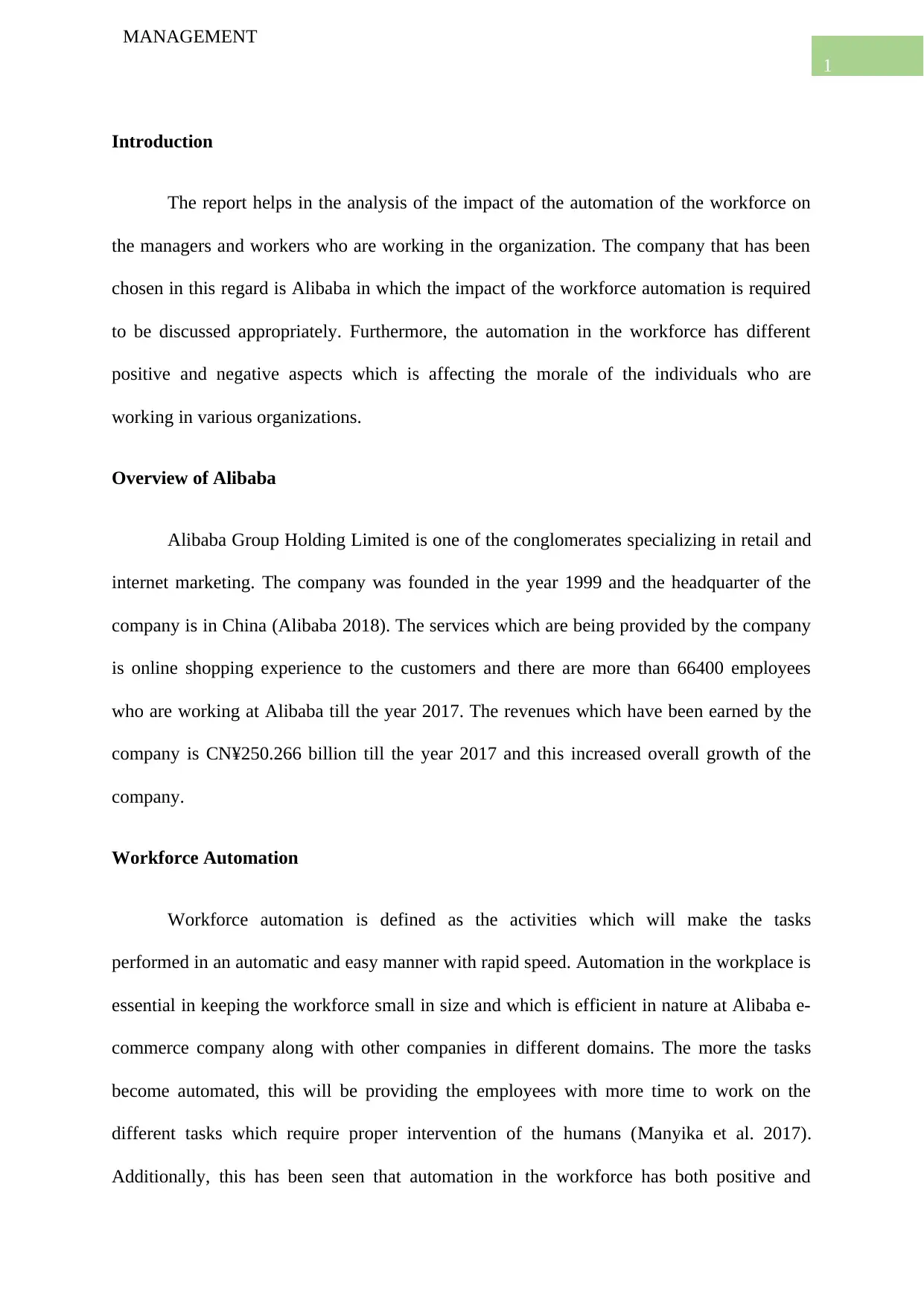
1
MANAGEMENT
Introduction
The report helps in the analysis of the impact of the automation of the workforce on
the managers and workers who are working in the organization. The company that has been
chosen in this regard is Alibaba in which the impact of the workforce automation is required
to be discussed appropriately. Furthermore, the automation in the workforce has different
positive and negative aspects which is affecting the morale of the individuals who are
working in various organizations.
Overview of Alibaba
Alibaba Group Holding Limited is one of the conglomerates specializing in retail and
internet marketing. The company was founded in the year 1999 and the headquarter of the
company is in China (Alibaba 2018). The services which are being provided by the company
is online shopping experience to the customers and there are more than 66400 employees
who are working at Alibaba till the year 2017. The revenues which have been earned by the
company is CN¥250.266 billion till the year 2017 and this increased overall growth of the
company.
Workforce Automation
Workforce automation is defined as the activities which will make the tasks
performed in an automatic and easy manner with rapid speed. Automation in the workplace is
essential in keeping the workforce small in size and which is efficient in nature at Alibaba e-
commerce company along with other companies in different domains. The more the tasks
become automated, this will be providing the employees with more time to work on the
different tasks which require proper intervention of the humans (Manyika et al. 2017).
Additionally, this has been seen that automation in the workforce has both positive and
MANAGEMENT
Introduction
The report helps in the analysis of the impact of the automation of the workforce on
the managers and workers who are working in the organization. The company that has been
chosen in this regard is Alibaba in which the impact of the workforce automation is required
to be discussed appropriately. Furthermore, the automation in the workforce has different
positive and negative aspects which is affecting the morale of the individuals who are
working in various organizations.
Overview of Alibaba
Alibaba Group Holding Limited is one of the conglomerates specializing in retail and
internet marketing. The company was founded in the year 1999 and the headquarter of the
company is in China (Alibaba 2018). The services which are being provided by the company
is online shopping experience to the customers and there are more than 66400 employees
who are working at Alibaba till the year 2017. The revenues which have been earned by the
company is CN¥250.266 billion till the year 2017 and this increased overall growth of the
company.
Workforce Automation
Workforce automation is defined as the activities which will make the tasks
performed in an automatic and easy manner with rapid speed. Automation in the workplace is
essential in keeping the workforce small in size and which is efficient in nature at Alibaba e-
commerce company along with other companies in different domains. The more the tasks
become automated, this will be providing the employees with more time to work on the
different tasks which require proper intervention of the humans (Manyika et al. 2017).
Additionally, this has been seen that automation in the workforce has both positive and
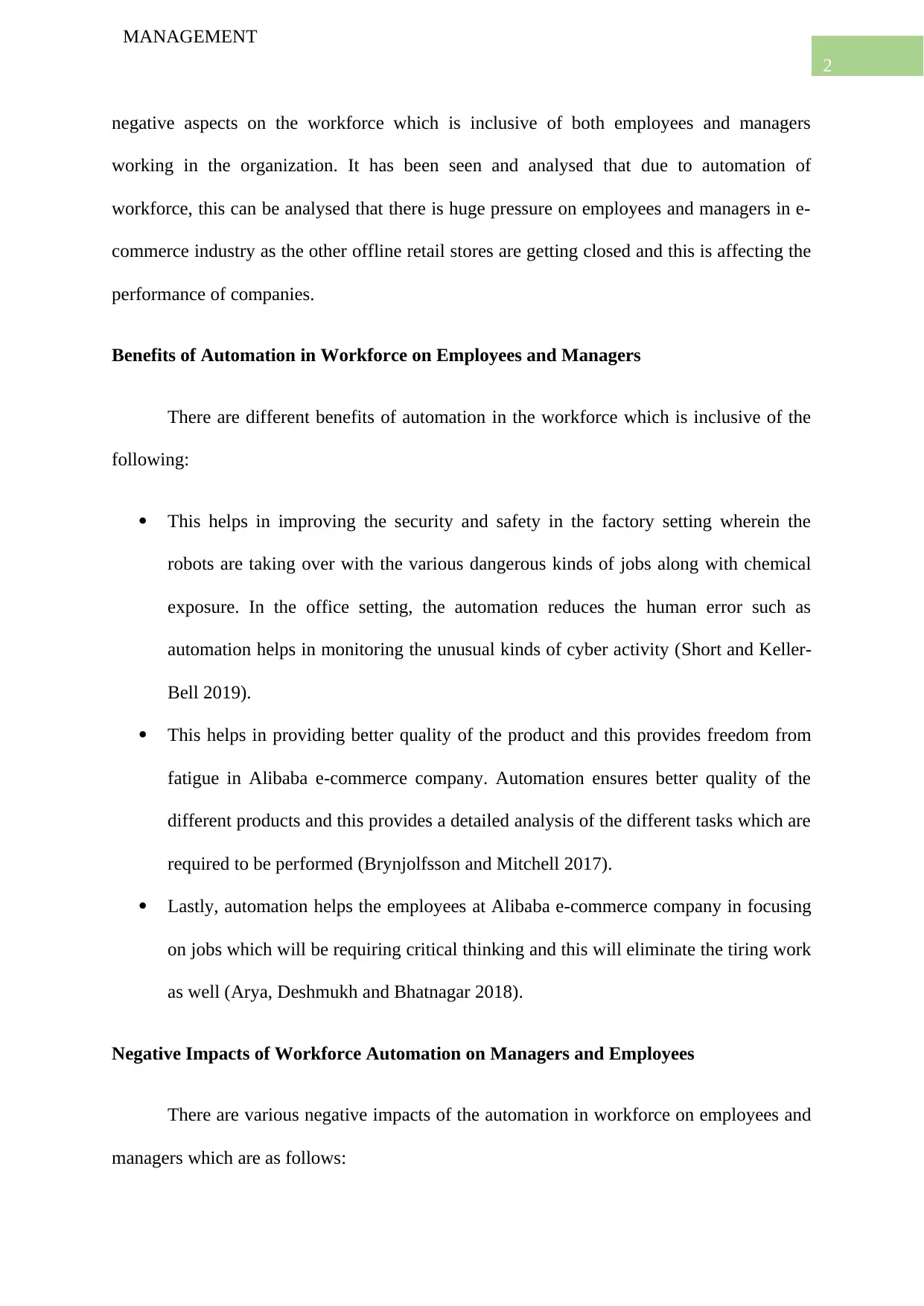
2
MANAGEMENT
negative aspects on the workforce which is inclusive of both employees and managers
working in the organization. It has been seen and analysed that due to automation of
workforce, this can be analysed that there is huge pressure on employees and managers in e-
commerce industry as the other offline retail stores are getting closed and this is affecting the
performance of companies.
Benefits of Automation in Workforce on Employees and Managers
There are different benefits of automation in the workforce which is inclusive of the
following:
This helps in improving the security and safety in the factory setting wherein the
robots are taking over with the various dangerous kinds of jobs along with chemical
exposure. In the office setting, the automation reduces the human error such as
automation helps in monitoring the unusual kinds of cyber activity (Short and Keller-
Bell 2019).
This helps in providing better quality of the product and this provides freedom from
fatigue in Alibaba e-commerce company. Automation ensures better quality of the
different products and this provides a detailed analysis of the different tasks which are
required to be performed (Brynjolfsson and Mitchell 2017).
Lastly, automation helps the employees at Alibaba e-commerce company in focusing
on jobs which will be requiring critical thinking and this will eliminate the tiring work
as well (Arya, Deshmukh and Bhatnagar 2018).
Negative Impacts of Workforce Automation on Managers and Employees
There are various negative impacts of the automation in workforce on employees and
managers which are as follows:
MANAGEMENT
negative aspects on the workforce which is inclusive of both employees and managers
working in the organization. It has been seen and analysed that due to automation of
workforce, this can be analysed that there is huge pressure on employees and managers in e-
commerce industry as the other offline retail stores are getting closed and this is affecting the
performance of companies.
Benefits of Automation in Workforce on Employees and Managers
There are different benefits of automation in the workforce which is inclusive of the
following:
This helps in improving the security and safety in the factory setting wherein the
robots are taking over with the various dangerous kinds of jobs along with chemical
exposure. In the office setting, the automation reduces the human error such as
automation helps in monitoring the unusual kinds of cyber activity (Short and Keller-
Bell 2019).
This helps in providing better quality of the product and this provides freedom from
fatigue in Alibaba e-commerce company. Automation ensures better quality of the
different products and this provides a detailed analysis of the different tasks which are
required to be performed (Brynjolfsson and Mitchell 2017).
Lastly, automation helps the employees at Alibaba e-commerce company in focusing
on jobs which will be requiring critical thinking and this will eliminate the tiring work
as well (Arya, Deshmukh and Bhatnagar 2018).
Negative Impacts of Workforce Automation on Managers and Employees
There are various negative impacts of the automation in workforce on employees and
managers which are as follows:
⊘ This is a preview!⊘
Do you want full access?
Subscribe today to unlock all pages.

Trusted by 1+ million students worldwide
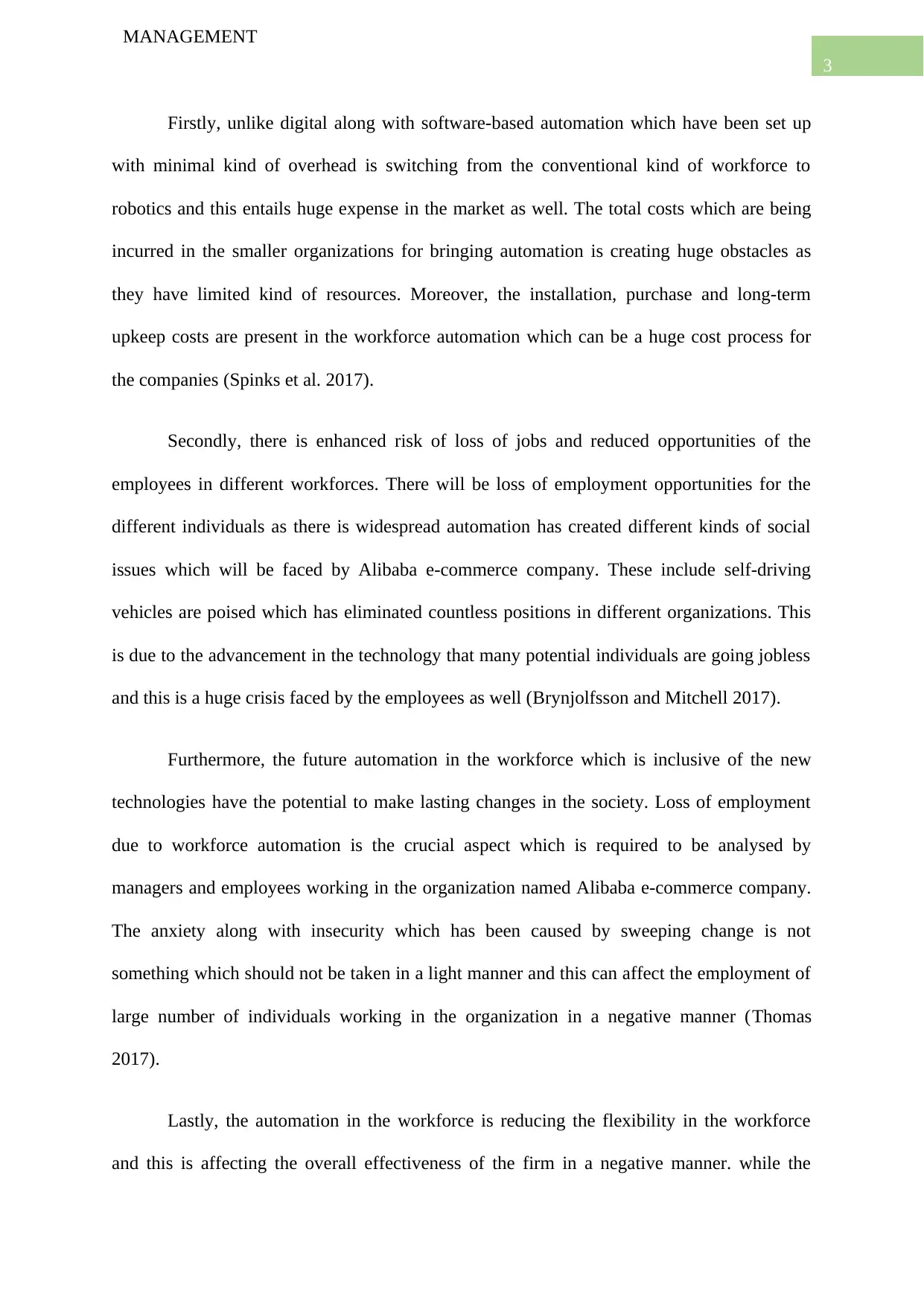
3
MANAGEMENT
Firstly, unlike digital along with software-based automation which have been set up
with minimal kind of overhead is switching from the conventional kind of workforce to
robotics and this entails huge expense in the market as well. The total costs which are being
incurred in the smaller organizations for bringing automation is creating huge obstacles as
they have limited kind of resources. Moreover, the installation, purchase and long-term
upkeep costs are present in the workforce automation which can be a huge cost process for
the companies (Spinks et al. 2017).
Secondly, there is enhanced risk of loss of jobs and reduced opportunities of the
employees in different workforces. There will be loss of employment opportunities for the
different individuals as there is widespread automation has created different kinds of social
issues which will be faced by Alibaba e-commerce company. These include self-driving
vehicles are poised which has eliminated countless positions in different organizations. This
is due to the advancement in the technology that many potential individuals are going jobless
and this is a huge crisis faced by the employees as well (Brynjolfsson and Mitchell 2017).
Furthermore, the future automation in the workforce which is inclusive of the new
technologies have the potential to make lasting changes in the society. Loss of employment
due to workforce automation is the crucial aspect which is required to be analysed by
managers and employees working in the organization named Alibaba e-commerce company.
The anxiety along with insecurity which has been caused by sweeping change is not
something which should not be taken in a light manner and this can affect the employment of
large number of individuals working in the organization in a negative manner (Thomas
2017).
Lastly, the automation in the workforce is reducing the flexibility in the workforce
and this is affecting the overall effectiveness of the firm in a negative manner. while the
MANAGEMENT
Firstly, unlike digital along with software-based automation which have been set up
with minimal kind of overhead is switching from the conventional kind of workforce to
robotics and this entails huge expense in the market as well. The total costs which are being
incurred in the smaller organizations for bringing automation is creating huge obstacles as
they have limited kind of resources. Moreover, the installation, purchase and long-term
upkeep costs are present in the workforce automation which can be a huge cost process for
the companies (Spinks et al. 2017).
Secondly, there is enhanced risk of loss of jobs and reduced opportunities of the
employees in different workforces. There will be loss of employment opportunities for the
different individuals as there is widespread automation has created different kinds of social
issues which will be faced by Alibaba e-commerce company. These include self-driving
vehicles are poised which has eliminated countless positions in different organizations. This
is due to the advancement in the technology that many potential individuals are going jobless
and this is a huge crisis faced by the employees as well (Brynjolfsson and Mitchell 2017).
Furthermore, the future automation in the workforce which is inclusive of the new
technologies have the potential to make lasting changes in the society. Loss of employment
due to workforce automation is the crucial aspect which is required to be analysed by
managers and employees working in the organization named Alibaba e-commerce company.
The anxiety along with insecurity which has been caused by sweeping change is not
something which should not be taken in a light manner and this can affect the employment of
large number of individuals working in the organization in a negative manner (Thomas
2017).
Lastly, the automation in the workforce is reducing the flexibility in the workforce
and this is affecting the overall effectiveness of the firm in a negative manner. while the
Paraphrase This Document
Need a fresh take? Get an instant paraphrase of this document with our AI Paraphraser
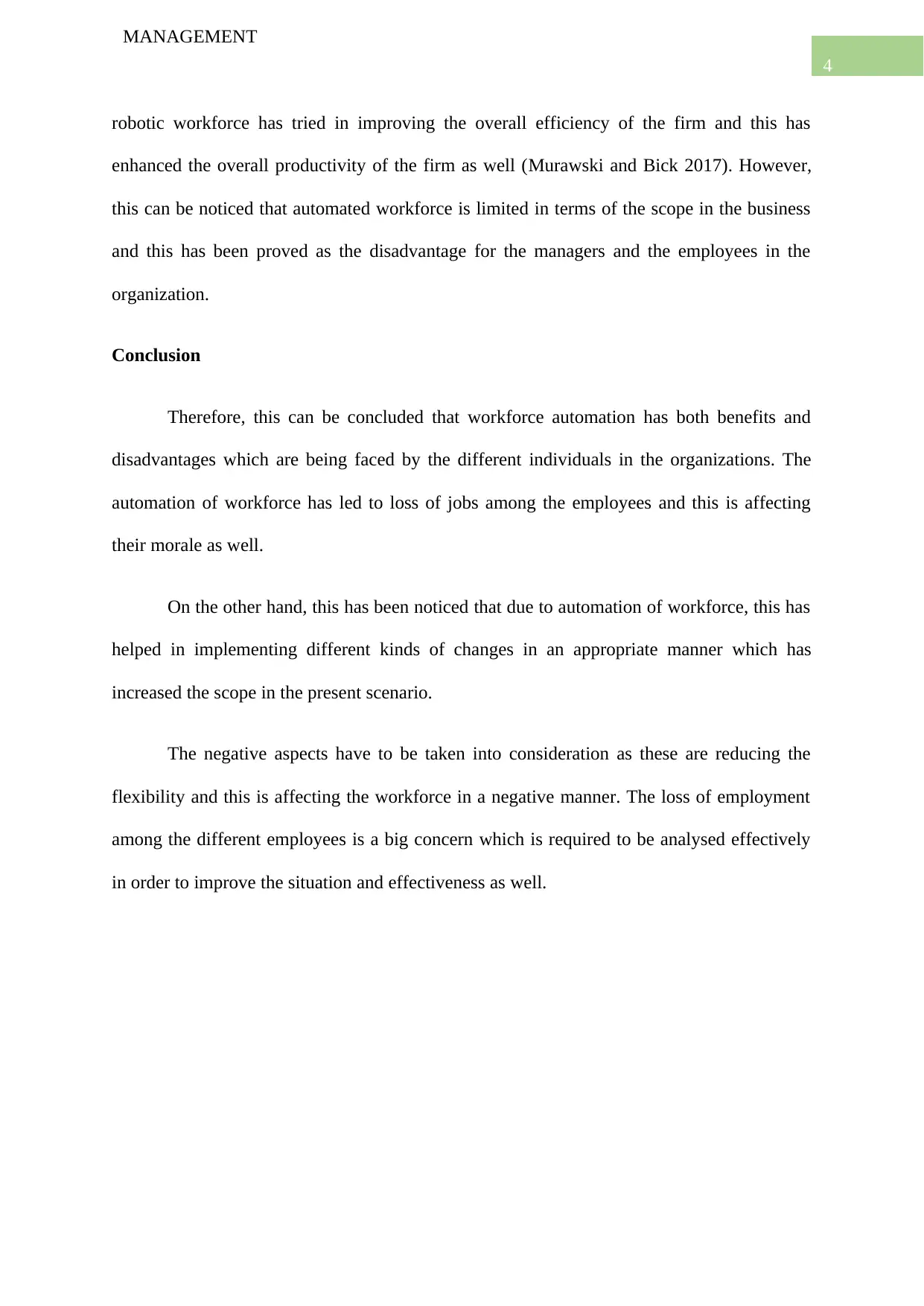
4
MANAGEMENT
robotic workforce has tried in improving the overall efficiency of the firm and this has
enhanced the overall productivity of the firm as well (Murawski and Bick 2017). However,
this can be noticed that automated workforce is limited in terms of the scope in the business
and this has been proved as the disadvantage for the managers and the employees in the
organization.
Conclusion
Therefore, this can be concluded that workforce automation has both benefits and
disadvantages which are being faced by the different individuals in the organizations. The
automation of workforce has led to loss of jobs among the employees and this is affecting
their morale as well.
On the other hand, this has been noticed that due to automation of workforce, this has
helped in implementing different kinds of changes in an appropriate manner which has
increased the scope in the present scenario.
The negative aspects have to be taken into consideration as these are reducing the
flexibility and this is affecting the workforce in a negative manner. The loss of employment
among the different employees is a big concern which is required to be analysed effectively
in order to improve the situation and effectiveness as well.
MANAGEMENT
robotic workforce has tried in improving the overall efficiency of the firm and this has
enhanced the overall productivity of the firm as well (Murawski and Bick 2017). However,
this can be noticed that automated workforce is limited in terms of the scope in the business
and this has been proved as the disadvantage for the managers and the employees in the
organization.
Conclusion
Therefore, this can be concluded that workforce automation has both benefits and
disadvantages which are being faced by the different individuals in the organizations. The
automation of workforce has led to loss of jobs among the employees and this is affecting
their morale as well.
On the other hand, this has been noticed that due to automation of workforce, this has
helped in implementing different kinds of changes in an appropriate manner which has
increased the scope in the present scenario.
The negative aspects have to be taken into consideration as these are reducing the
flexibility and this is affecting the workforce in a negative manner. The loss of employment
among the different employees is a big concern which is required to be analysed effectively
in order to improve the situation and effectiveness as well.
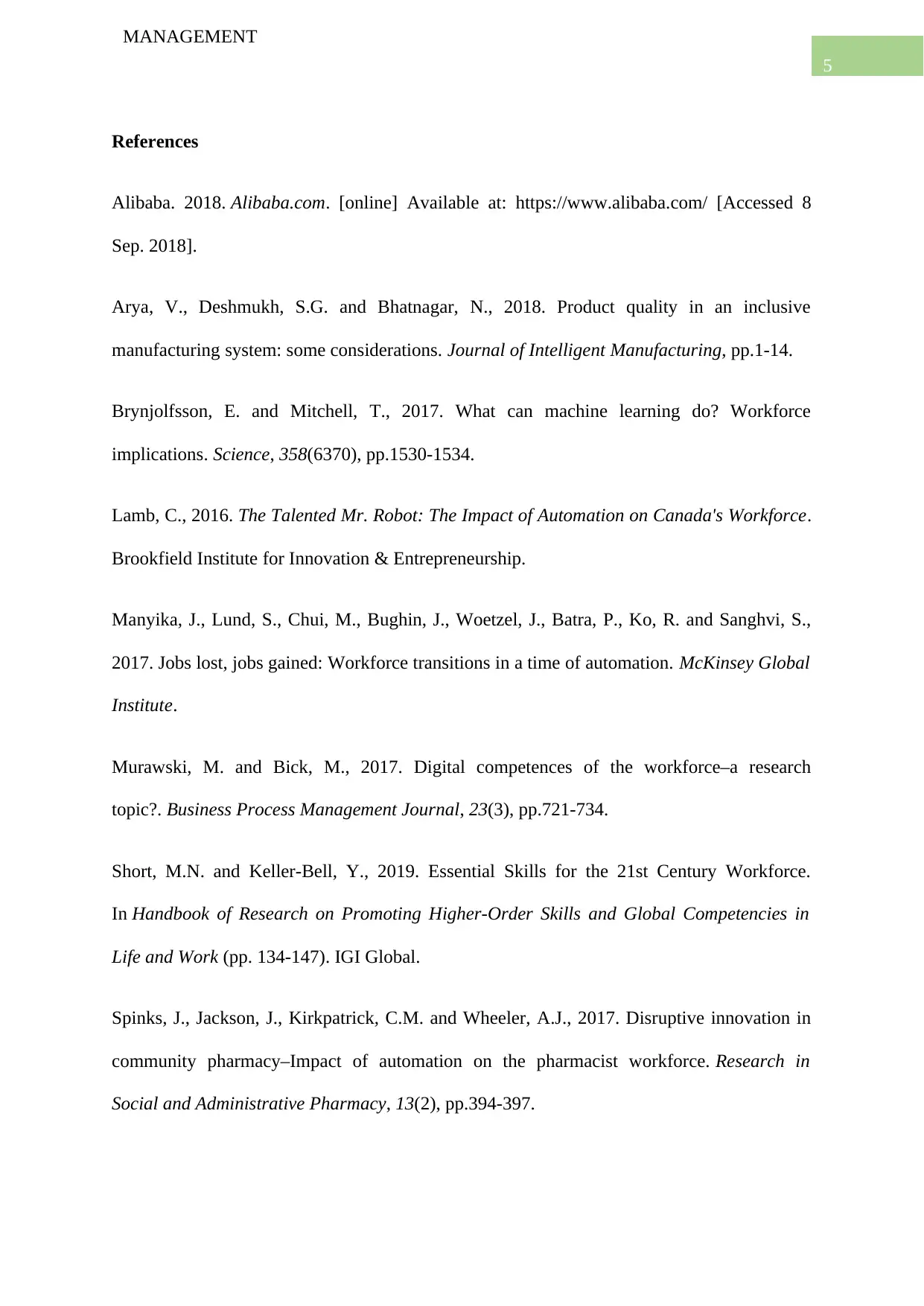
5
MANAGEMENT
References
Alibaba. 2018. Alibaba.com. [online] Available at: https://www.alibaba.com/ [Accessed 8
Sep. 2018].
Arya, V., Deshmukh, S.G. and Bhatnagar, N., 2018. Product quality in an inclusive
manufacturing system: some considerations. Journal of Intelligent Manufacturing, pp.1-14.
Brynjolfsson, E. and Mitchell, T., 2017. What can machine learning do? Workforce
implications. Science, 358(6370), pp.1530-1534.
Lamb, C., 2016. The Talented Mr. Robot: The Impact of Automation on Canada's Workforce.
Brookfield Institute for Innovation & Entrepreneurship.
Manyika, J., Lund, S., Chui, M., Bughin, J., Woetzel, J., Batra, P., Ko, R. and Sanghvi, S.,
2017. Jobs lost, jobs gained: Workforce transitions in a time of automation. McKinsey Global
Institute.
Murawski, M. and Bick, M., 2017. Digital competences of the workforce–a research
topic?. Business Process Management Journal, 23(3), pp.721-734.
Short, M.N. and Keller-Bell, Y., 2019. Essential Skills for the 21st Century Workforce.
In Handbook of Research on Promoting Higher-Order Skills and Global Competencies in
Life and Work (pp. 134-147). IGI Global.
Spinks, J., Jackson, J., Kirkpatrick, C.M. and Wheeler, A.J., 2017. Disruptive innovation in
community pharmacy–Impact of automation on the pharmacist workforce. Research in
Social and Administrative Pharmacy, 13(2), pp.394-397.
MANAGEMENT
References
Alibaba. 2018. Alibaba.com. [online] Available at: https://www.alibaba.com/ [Accessed 8
Sep. 2018].
Arya, V., Deshmukh, S.G. and Bhatnagar, N., 2018. Product quality in an inclusive
manufacturing system: some considerations. Journal of Intelligent Manufacturing, pp.1-14.
Brynjolfsson, E. and Mitchell, T., 2017. What can machine learning do? Workforce
implications. Science, 358(6370), pp.1530-1534.
Lamb, C., 2016. The Talented Mr. Robot: The Impact of Automation on Canada's Workforce.
Brookfield Institute for Innovation & Entrepreneurship.
Manyika, J., Lund, S., Chui, M., Bughin, J., Woetzel, J., Batra, P., Ko, R. and Sanghvi, S.,
2017. Jobs lost, jobs gained: Workforce transitions in a time of automation. McKinsey Global
Institute.
Murawski, M. and Bick, M., 2017. Digital competences of the workforce–a research
topic?. Business Process Management Journal, 23(3), pp.721-734.
Short, M.N. and Keller-Bell, Y., 2019. Essential Skills for the 21st Century Workforce.
In Handbook of Research on Promoting Higher-Order Skills and Global Competencies in
Life and Work (pp. 134-147). IGI Global.
Spinks, J., Jackson, J., Kirkpatrick, C.M. and Wheeler, A.J., 2017. Disruptive innovation in
community pharmacy–Impact of automation on the pharmacist workforce. Research in
Social and Administrative Pharmacy, 13(2), pp.394-397.
⊘ This is a preview!⊘
Do you want full access?
Subscribe today to unlock all pages.

Trusted by 1+ million students worldwide

6
MANAGEMENT
Thomas, P.B.M., 2017. Bespoke automation of medical workforce rostering using Google’s
free cloud applications. Journal of innovation in health informatics, 24(4), pp.334-338.
MANAGEMENT
Thomas, P.B.M., 2017. Bespoke automation of medical workforce rostering using Google’s
free cloud applications. Journal of innovation in health informatics, 24(4), pp.334-338.
1 out of 7
Related Documents
Your All-in-One AI-Powered Toolkit for Academic Success.
+13062052269
info@desklib.com
Available 24*7 on WhatsApp / Email
![[object Object]](/_next/static/media/star-bottom.7253800d.svg)
Unlock your academic potential
Copyright © 2020–2025 A2Z Services. All Rights Reserved. Developed and managed by ZUCOL.





